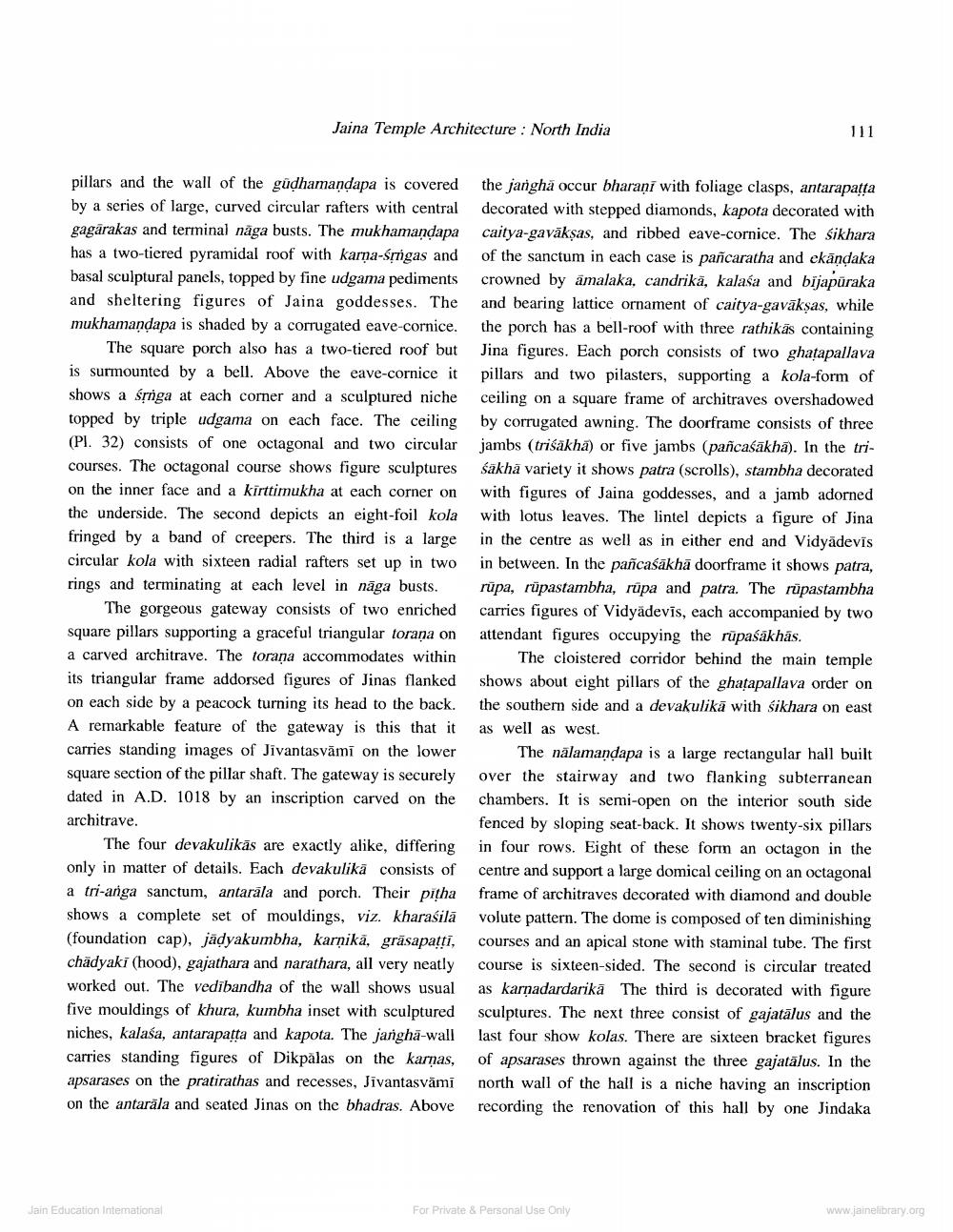________________
Jaina Temple Architecture : North India
pillars and the wall of the gūdhamandapa is covered the janghä occur bharaṇi with foliage clasps, antarapatta by a series of large, curved circular rafters with central decorated with stepped diamonds, kapota decorated with gagarakas and terminal näga busts. The mukhamandapa caitya-gavākşas, and ribbed eave-cornice. The Sikhara has a two-tiered pyramidal roof with karņa-śrrigas and of the sanctum in each case is pañcaratha and ekāndaka basal sculptural panels, topped by fine udgama pediments crowned by amalaka, candrika, kalasa and bijapüraka and sheltering figures of Jaina goddesses. The and bearing lattice ornament of caitya-gavākşas, while mukhamandapa is shaded by a corrugated eave-cornice. the porch has a bell-roof with three rathikäs containing
The square porch also has a two-tiered roof but Jina figures. Each porch consists of two ghatapallava is surmounted by a bell. Above the eave-cornice it pillars and two pilasters, supporting a kola-form of shows a śråga at each corner and a sculptured niche ceiling on a square frame of architraves overshadowed topped by triple udgama on each face. The ceiling by corrugated awning. The doorframe consists of three (Pl. 32) consists of one octagonal and two circular jambs (trišakha) or five jambs (pañcaśākha). In the tricourses. The octagonal course shows figure sculptures sākha variety it shows patra (scrolls), stambha decorated on the inner face and a kirttimukha at each corner on with figures of Jaina goddesses, and a jamb adorned the underside. The second depicts an eight-foil kola with lotus leaves. The lintel depicts a figure of Jina fringed by a band of creepers. The third is a large in the centre as well as in either end and Vidyādevis circular kola with sixteen radial rafters set up in two in between. In the pañcaśākhā doorframe it shows patra, rings and terminating at each level in nāga busts. rūpa, rüpastambha, rūpa and patra. The rüpastambha
The gorgeous gateway consists of two enriched carries figures of Vidyadevis, each accompanied by two square pillars supporting a graceful triangular torana on attendant figures occupying the rūpasākhās. a carved architrave. The torana accommodates within The cloistered corridor behind the main temple its triangular frame addorsed figures of Jinas flanked shows about eight pillars of the ghatapallava order on on each side by a peacock turning its head to the back. the southern side and a devakulikā with sikhara on east A remarkable feature of the gateway is this that it as well as west. carries standing images of Jivantasvāmi on the lower The nalamandapa is a large rectangular hall built square section of the pillar shaft. The gateway is securely over the stairway and two flanking subterranean dated in A.D. 1018 by an inscription carved on the chambers. It is semi-open on the interior south side architrave.
fenced by sloping seat-back. It shows twenty-six pillars The four devakulikās are exactly alike, differing in four rows. Eight of these form an octagon in the only in matter of details. Each devakulikā consists of centre and support a large domical ceiling on an octagonal a tri-anga sanctum, antarala and porch. Their pitha frame of architraves decorated with diamond and double shows a complete set of mouldings, viz. kharasila volute pattern. The dome is composed of ten diminishing (foundation cap), jādyakumbha, karņikā, gräsapatti, courses and an apical stone with staminal tube. The first chädyaki (hood), gajathara and narathara, all very neatly course is sixteen-sided. The second is circular treated worked out. The vedībandha of the wall shows usual as karņadardarikā The third is decorated with figure five mouldings of khura, kumbha inset with sculptured sculptures. The next three consist of gajatālus and the niches, kalaša, antarapatta and kapota. The jangha-wall last four show kolas. There are sixteen bracket figures carries standing figures of Dikpālas on the karņas, of apsarases thrown against the three gajatālus. In the apsarases on the pratirathas and recesses, Jivantasvāmi north wall of the hall is a niche having an inscription on the antarala and seated Jinas on the bhadras. Above recording the renovation of this hall by one Jindaka
Jain Education International
www.jainelibrary.org
International
For Private & Personal Use Only




